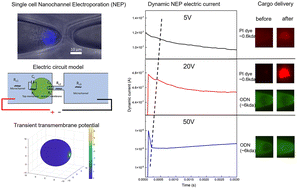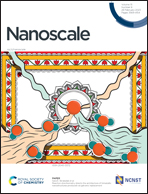Cell membrane damage and cargo delivery in nano-electroporation†
Abstract
Nanochannel electroporation (NEP) is a new technology for cell transfection, which provides superior gene delivery and cell viability to conventional bulk electroporation (BEP). In NEP, the cells laid on a porous substrate are subjected to an asymmetric electric field which induces asymmetric membrane poration. The cell membrane near the channel outlet (‘transfection membrane’) is porated intensely, allowing direct delivery of genetic materials, while the rest of the cell membrane (‘non-transfection membrane’) remains much less perturbed for low cellular damage. In this work, the transfection window of NEP for the delivery of different sized molecules is systematically investigated. The results show that small molecules (∼0.6 kDa) can be delivered into cells at a relatively lower voltage without significantly impacting the non-transfection membrane. To deliver larger molecules (∼6 kDa), a higher working voltage is required at the cost of cell viability due to more severe damage of the non-transfection membrane. Through numerical analysis of both transient transmembrane potential (t-TMP) and dynamic transmembrane potential (d-TMP), here we show that the membrane damage on both transfection and non-transfection sides of the cell membrane can be predicted. The agreement between experimental results and numerical analysis provides a comprehensive understanding of cell membrane damage and cargo delivery in NEP.



 Please wait while we load your content...
Please wait while we load your content...